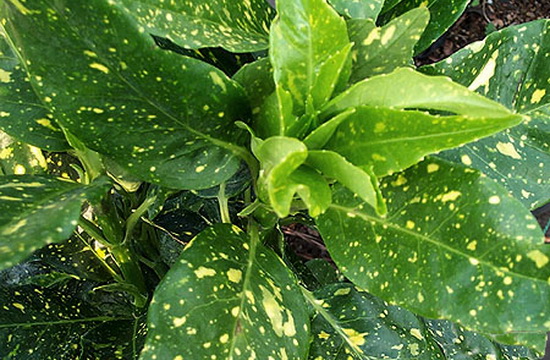Aucuba plant (Aucuba) is an original ornamental shrub with large green-yellow leaves, as if decorated with sun glare. It is thanks to this coloring that the plant received the name “golden tree”.
In home horticulture, aucuba can be used for decoration both in sunny areas and in moderately shaded rooms. In nature, the “golden tree” aucuba forms an undergrowth in the forests of the subtropical zone, is found in the Himalayas, Japan, and Korea.
Aucuba is a unisexual, dioecious plant, so two “golden trees” are required to form seeds.
Photo of Japanese aukuba
In culture, various forms of Japanese aukuba (Aucu bajaponica) are mainly common – a branchy shrub up to 1.5 m high, with leathery oval leaves (up to 20 cm long and 6 cm wide), with entire or serrated edges.

In the photo of the aucuba, you can also see options with plain green leaves or with variegated coloring of leaf plates.
Small bright red flowers of the Japanese aukuba are collected in panicle inflorescences. The fruits are red berries.
Caring for the “golden tree” aucuba at home
“Golden Tree” is a relatively unpretentious plant that grows well in both warm and cool rooms. Caring for aucuba at home is not at all difficult, since this plant is undemanding to the level of illumination: trees with plain green leaves easily tolerate shade, and variegated forms on brightly lit windows only become more beautiful.
Aucuba does not like summer heat, quickly ages and loses leaves, the optimum temperature for it is about +20 ° C, it is advisable to take the plant outdoors to a place protected from sunlight, wind and rain. From the end of September, the temperature is gradually reduced to + 14 ° C, and by winter to + 8 ° … + 12 ° C. If the plant is kept at room temperature in winter, then it should be sprayed daily and provide additional lighting, otherwise it may drop leaves.
Aucuba is watered abundantly in summer, moderately in autumn and winter, allowing the soil to dry out completely, as black spots appear on the leaves with excessive moisture. In summer, it is not necessary to spray, and in winter, when kept cool, it should not be at all, since mold may develop.
Top dressing is carried out during the period of active growth once a week, mineral and organic fertilizers alternate. In the spring, formative pruning is required, and the resulting cuttings are used for propagation. Young specimens are transplanted annually, adults once every 2-3 years by transshipment, so as not to injure fragile roots.
All parts of the plant, especially the berries, are poisonous. Care must be taken when working with the plant!







